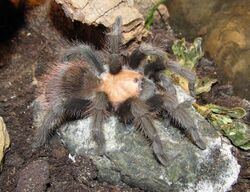Biology:Brachypelma albiceps
| Brachypelma albiceps | |
|---|---|

| |
| Subadult female in captivity | |
| Scientific classification | |
| Domain: | Eukaryota |
| Kingdom: | Animalia |
| Phylum: | Arthropoda |
| Subphylum: | Chelicerata |
| Class: | Arachnida |
| Order: | Araneae |
| Infraorder: | Mygalomorphae |
| Family: | Theraphosidae |
| Genus: | Brachypelma |
| Species: | B. albiceps
|
| Binomial name | |
| Brachypelma albiceps Pocock, 1903[2]
| |
| Synonyms[2] | |
| |
Brachypelma albiceps is a species of spider in the tarantula family, Theraphosidae.[2] It is known as the Mexican golden red rump tarantula or the Amula red rump tarantula. The carapace is a light golden color and the abdomen dark, covered with long red hairs. Females typically live for about 15 years (up to 20). Males usually live about 5 years or up to 12 months after the last molt.[3][4]
Description
Females of Brachypelma albiceps have a body length of about 65 mm. The fourth leg is longest at about 60 mm. The carapace is covered with fine hair; its apparent color depends on the illumination, varying from sandy grey through to rose or yellow. The pedipalps and the first two pairs of legs may be lighter than the last two pairs of legs. The abdomen is dark with bright red longish hairs (setae). The spermatheca has two rounded seminal receptacles.[5][6]
Taxonomy
Brachypelma albiceps has a somewhat tangled taxonomic history. In 1897, F. O. Pickard-Cambridge described the species Eurypelma pallidum (now Aphonopelma pallidum) on the basis of two males collected in Chihuahua, Mexico. He assumed that two female specimens, collected independently in Guerrero, belonged to the same species.[7] In 1903, R. I. Pocock used the new name Brachypelma albiceps for these two females. He did not give a full description, merely saying in a footnote that the name was for the females from Guerrero that Pickard-Cambridge had doubtfully assigned to the same species as the males.[8] Alexander Petrunkevitch in 1939 and Carl Roewer in 1942 restored Pickard-Cambridge's original name, treating albiceps in this context as a junior synonym of pallidum. After studying the original specimens (which neither Petrunkevitch nor Roewer had done), Andrew Smith in 1995 reinstated Pocock's distinction, recognizing the females as a separate species, which, however, he placed in the genus Aphonopelma rather than Brachypelma.[5]
In 1997, Günter Schmidt described a new species, Brachypelmides ruhnaui from both sexes,[9] and in 2004, transferred Pocock's Brachypelma albiceps to Brachypelmides.[10] In 2005, Arturo Locht et al. restored Smith's Aphonopelma albiceps to its current genus Brachypelma and also synonymized Schmidt's Brachypelmides ruhnaui.[11][2]
Distribution and habitat
Brachypelma albiceps is endemic to the central highlands of Mexico, especially in Guerrero and south of Morelos. In the wild, they build long burrows, typically under large rocks, but may inhabit nests abandoned by rodents or other animals. They are most active at night and dusk.[3]
Conservation
In 1994, all Brachypelma species were placed on CITES Appendix II, thus restricting trade.[12] Nevertheless, large numbers of tarantulas caught in the wild continue to be smuggled out of Mexico, including species of Brachypelma.[13]
Food
Their diet typically includes crickets, grasshoppers, beetles, and cockroaches. In captivity, live food is typically required, such as moths, mealworms and pinky mice, as dead food may be ignored.[citation needed]
Reproduction
Females lay cocoons containing roughly 500 (up to 900) eggs two months after mating. Spiderlings hatch 8–10 weeks later.[3]
Pets
B. albiceps is commonly available at pet stores. Lighting is not needed, as these spiders naturally prefer darkness.[3]
References
- ↑ "Appendices | CITES". https://cites.org/eng/app/appendices.php.
- ↑ 2.0 2.1 2.2 2.3 "Taxon details Brachypelma albiceps Pocock, 1903". World Spider Catalog. Natural History Museum Bern. http://www.wsc.nmbe.ch/species/37244. Retrieved 2017-09-29.
- ↑ 3.0 3.1 3.2 3.3 "Brachypelma albiceps". 14 January 2020. http://www.terrarium.com.pl/zobacz/brachypelma-albiceps-630.html.
- ↑ "Brachypelma albiceps (Mexican Golden Redrump Tarantula)". http://brachypelma.org/index.php?option=com_content&view=article&id=12:balbiceps&catid=7:bcaresheets&Itemid=50.
- ↑ 5.0 5.1 Smith, Andrew M. (1994), Tarantula Spiders: Tarantulas of the U.S.A. and Mexico, London: Fitzgerald Publishing, ISBN 978-0-9510939-9-3 p. 136.
- ↑ Peters, Heinz-Josef (2003). "Aphonopelma albiceps Pocock, 1903" (in de). Amerika's Vogelspinnen. Tarantulas of the World. Wegberg: H.-J. Peters. pp. 32–33. ISBN 978-3-933443-06-9.
- ↑ Pickard-Cambridge, F.O. (1897). "Eurypelma pallidum, sp. n.". Arachnida - Araneida and Opiliones, vol. 2. Biologia Centrali-Americana. London. p. 21.
- ↑ Pocock, R. I. (1903). "On some genera and species of South-American Aviculariidae". Annals and Magazine of Natural History. Series 7 11 (61): 81–115. doi:10.1080/00222930308678729. https://zenodo.org/record/1430015.
- ↑ Schmidt, G. (1997). "Eine zweite Brachypelmides-Art aus Mexiko: Brachypelmides ruhnaui n. sp. (Arachnida: Araneae: Theraphosidae: Theraphosinae)" (in de). Entomologische Zeitschrift, Frankfurt a.M. 107: 205–208.
- ↑ Schmidt, G. (2004). "Die Gattung Brachypelmides Schmidt & Krause, 1994 (Araneae: Theraphosidae: Theraphosinae)" (in de). Tarantulas of the World 99: 4–5.
- ↑ Locht, A.; Medina, F.; Rojo, R.; Vázquez, I. (2005). "Una nueva especie de tarántula del género Aphonopelma Pocock 1901 (Araneae, Theraphosidae, Theraphosinae) de México con notas sobre el género Brachypelma Simon 1891" (in es). Boletín de la Sociedad Entomologica Aragonesa 37: 105–108.
- ↑ "Brachypelma smithi (F. O. Pickard-Cambridge, 1897): Documents". UNEP-WCMC & CITES Secretariat. https://speciesplus.net/#/taxon_concepts/6716/documents. Retrieved 2017-09-22.
- ↑ Mendoza, J.; Francke, O. (2017). "Systematic revision of Brachypelma red-kneed tarantulas (Araneae: Theraphosidae), and the use of DNA barcodes to assist in the identification and conservation of CITES-listed species". Invertebrate Systematics 31 (2): 157–179. doi:10.1071/IS16023.
External links
- Hijmensen, Eddy (2011). "Brachypelma albiceps". http://mantid.nl/tarantula/Albiceps.html. Retrieved 2017-10-05. – photographs taken in the wild
Wikidata ☰ Q378127 entry
 |

